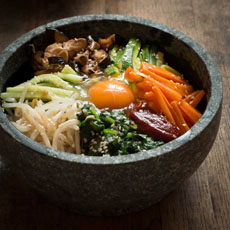TIP OF THE DAY: Bibimbap, A Korean Classic For The Lunar New Year
|
We love bibimbap (bee-bim-BOP), a signature Korean dish. It’s a variation of our currently trending rice bowl. The word literally means “mixed rice”—rice mixed with several other ingredients. We’ve written about bibimbap previously, but for the eve of the lunar new year (this year, it’s Sunday, February 7th), it’s especially appropriate. It’s what Koreans traditionally eat on their new year’s eve. It also happens to be Super Bowl Sunday; if your friends are foodies, this is a good dish for a crowd. A bowl of warm white rice is topped with seasoned vegetables*; sliced beef, chicken or seafood; and a raw or fried egg. The yolk of the egg (or the entire raw egg) binds the ingredients when they are mixed together. Chile paste, fermented soybean paste or soy sauce are served as condiments. After the ingredients are blended each individual diner, condiments added at the table. For visual appeal, the vegetables are often placed so that adjacent colors complement each other. The recipe below, from Good Eggs, requires 15 minutes of active time, and a total of 35 minutes. It doesn’t require you to be handy with a knife: Instead of thin slices of beef, you use ground beef. If you like bibimbap as much as we do, you can experiment with other grains. Quinoa bibimbap with kale, anyone? Ingredients For 4-6 Servings 1. RINSE the rice a few times in a fine-mesh sieve until the water runs clear. Add the rice to a pot and cover it with water. Let it soak for 20 minutes, then strain it again. Add the rice back to the pot and add 3 cups of water. Bring the rice and water to a boil, uncovered. When the water reaches a rolling boil… 2. TURN the flame to low, cover the pot and let the rice simmer for 20 minutes. After 20 minutes, turn the heat off and let it steam for 10 minutes with the cover on. After 10 minutes, fluff the rice with a fork: It’s ready. While the rice cooks 3. HEAT 2 tablespoons of olive oil in a pan. When the oil is hot, add the meat and break it up with the back of a wooden spoon. Turn the heat down and add the soy sauce and mirin, and stir. Cook for another 5-6 minutes, until the meat is cooked through. Remove from the heat. 4. SERVE: Spoon some rice into a bowl and sprinkle with sesame seeds, a splash of mirin, and a little bit of soy sauce. Top with beef, cilantro, scallions, radishes, cilantro and a spoonful of kimchi. Bibimbap was traditionally eaten on the eve of the lunar new year, to enable households to use up all of their leftovers before the start of the new year. All of the leftovers were put in a bowl of rice and mixed together. Use up your leftovers, or buy fresh ingredients. Or plan a party: Like paella and other rice main dishes, bibimbap is a good dish for a crowd. Of course, bibimbap can be made from scratch with chosen ingredients. Each region and each cook has a preferred mix of ingredients. At Korean restaurants you can get dolsot bibimbap (stone pot bibimbap), served in a stone bowl so hot that the ingredients sizzle. The raw egg cooks as soon as it’s mixed in. Before the rice is placed in the bowl, the bottom can be coated with sesame oil, which makes the bottom of the rice cook to a crispy state, like the socarrat at the bottom of the |
|
|
|
____________________________________
*Commonly vegetables used include bean sprouts, julienned cucumber, julienned or shredded daikon (Japanese radish), julienned zucchini, nori (dried seaweed), shredded carrots, sliced mushrooms or whole enoki mushrooms, and spinach. Diced tofu, either uncooked or cooked, can be added. †Mirin and saké are both called “rice wine.” Both are fermented from rice; mirin has a lower alcohol content and higher sugar content (as an analogy, think of sweet and dry vermouths. If you have saké but no mirin, make a substitute by adding a half teaspoon of sugar to the saké, and warm it slowly to dissolve the sugar.
|
||







